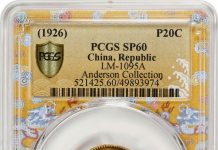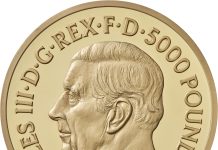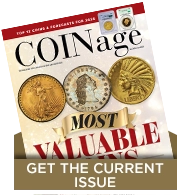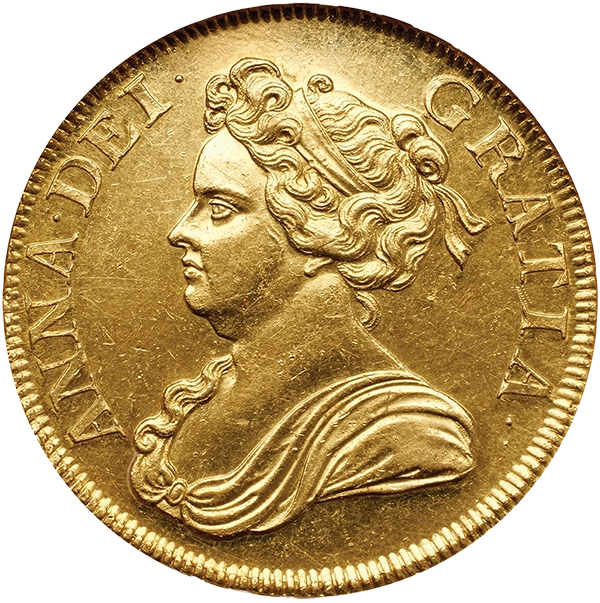
Auction features Peh Collection highlights
The premier event in the Americas for world-coin experts and enthusiasts is the annual New York International Numismatic Convention (NYINC), which was held in January at the InterContinental New York Barclay hotel, in the heart of New York City. Although there were major auctions by several firms at the convention, a top attraction was a collection of coins not auctioned or offered for sale there. The Goldbergs brought with them the first part of the Peh Collection, which was auctioned in Los Angeles about two weeks later.
On January 30, the firm of Ira & Larry Goldberg auctioned the first part of the Peh Collection at the Fairmont Century City hotel in Los Angeles. Of the slightly more than 220 coins, patterns, tokens and medals in the auction of the first part of the Peh Collection, around 85 of them were British. In terms of current market values and the traditional fame of rarities included, British coins and patterns dominated this auction.
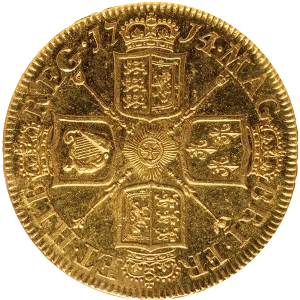
There were about 30 items from the United States in this first part of the Peh Collection. Twenty-five or so ancient coins were included. A few from Ancient Greece and a couple from the Roman Republic were followed by a noteworthy offering of coins from the Ancient Roman Empire. Five coins from Ancient Egypt were all struck between 300 BC and 100 BC. A very significant percentage of the items in this Peh Collection, Part 1, auction were struck during the 19th century and included European, Latin American, Asian and Oceanic coins.
The British Invasion
A large number of societies were represented in this auction; however, British coins were the highlight and the core of the first auction of the Peh Collection at the convention.
The first large-scale gold coinage program on the British Isles was based upon the noble denomination, introduced by King Edward III in the mid-14th century.
The leopard coin program of 1343-44 was a commercial failure because the gold content of the coin denominations was inconsistent with the monetary systems of Britain and important trading partners in Northern Europe. Today, the surviving leopards are among the rarest and greatest of all British coins.
Today, the surviving leopards are among the rarest and greatest of all British coins.”
King Edward III ruled England and pertinent territories from 1327 to 1377. Nobles, half-nobles and quarter-nobles were not replaced by other coin types until after 1450. As the noble gold-coin denomination was specified to be 80 silver pennies, it was worth one-third of a British pound and also worth one-half of a mark. British coins are now referenced by way of Spink reference numbers (spink.com) from the Spink Standard Catalogue, which is published every year.
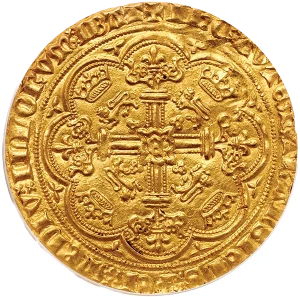
IMAGES COURTESY OF IRA & LARRY GOLDBERG COINS & COLLECTIBLES
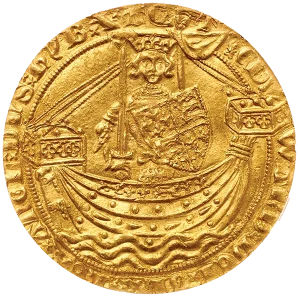
IMAGES COURTESY OF IRA & LARRY GOLDBERG COINS & COLLECTIBLES
The Edward III quarter-noble (Spink Catalogue #1511) in the Peh Collection was Professional Coin Grading Service (PCGS)-graded Mint State-64 on the one-through-70 scale: a very high grade for a medieval coin, considering that a grade of 70 is perfect. The price realized of $3,600 was a win for the buyer: If you can get a near-gem-quality gold coin from the 1300s for less than $4,000, you’ve done well. People pay far more than that for many 20th-century U.S. and British gold coins.
A PCGS-graded MS-63 Edward III noble (Spink Catalogue #1502) minted during the 1360s realized $16,200. This exact coin was auctioned by the Goldbergs in February 2006 for $3,480—less than one-fourth of the price in 2024.
Long Live the Queen
Mary was the first-born child of King Henry VIII and the granddaughter of Ferdinand & Isabella, the royal couple who united Spain and sponsored the voyages of Christopher Columbus. Queen Mary I impacted history much more so than most other monarchs. Her reign (1553-58), however, was brief: Queen Mary was only 42 years old when she died. The Peh Collection, Mary I Gold Sovereign weighs almost a half-troy ounce. This coin was an engrossing topic of discussion during lot-viewing sessions in New York. It was earlier in the Millennia Collection, which the Goldbergs auctioned on May 26, 2008, and was one of the all-time best collections of world coins.
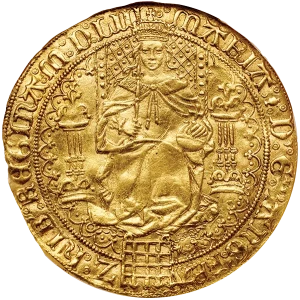
IMAGES COURTESY OF IRA & LARRY GOLDBERG COINS & COLLECTIBLES
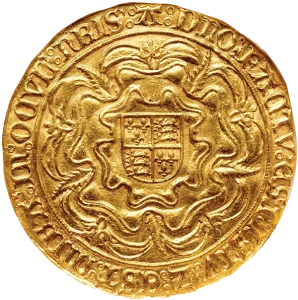
IMAGES COURTESY OF IRA & LARRY GOLDBERG COINS & COLLECTIBLES
This Queen Mary I Gold Sovereign is definitely uncirculated and is fairly well struck, with no very noticeable hairlines. Grading services typically make allowances for gold coins from past centuries, especially those minted before 1700. In 2024, I noted that PCGS did not assign a numerical grade to this Mary I Gold Sovereign, but instead called it “Unc. Details.” This Gold Sovereign was minted in 1553.
The prices realized were consistent with a viewpoint that this Mary I Gold Sovereign deserves a numerical grade. While NGC-certified as MS-62 in 2008, this coin realized $46,000 in an auction. In 2024, it realized $96,000—more than twice as much as it realized in 2008.
Screw-Press Technology
In 1558, Mary’s half-sister, Elizabeth, succeeded her as queen. They were both daughters of King Henry VIII. Under Elizabeth’s reign, the first British coins to be struck with a machine—a screw press—came about, though press-struck coins amounted only to a small percentage of the output of coins during her reign. Screw-press technology was not firmly adopted for coinage in England until 1662.
In the Peh Collection, there was an Elizabeth I half-pound (10 shilling) gold coin that was struck on a screw press between 1567 and 1570. This coin realized $31,050 in 2008, a very high price at the time. On Jan. 30 of this year, it realized $81,000—a super-high price.
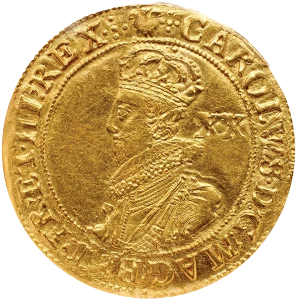
IMAGES COURTESY OF IRA & LARRY GOLDBERG COINS & COLLECTIBLES
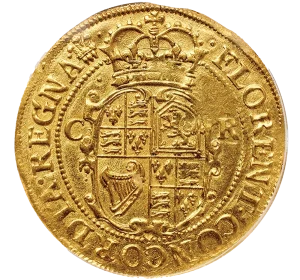
IMAGES COURTESY OF IRA & LARRY GOLDBERG COINS & COLLECTIBLES
Charles I Ushers in the Unites
Under Charles I, a new gold-coin type, called a Unite, became popular. As it was denominated as 20 shillings, it was a gold pound. In the Peh Collection, there was a PCGS-graded AU-55 Charles I Unite, minted in 1630 or 1631.
The Peh Collection Unite was pleasing. Given this Unite’s rarity and historical implications, the $6,600 paid is not a vast sum. People pay much more than $6,600 each for many U.S. and British 19th-century gold coins.
The most famous coin in the Peh Collection was the Queen Anne 1703 5 Guineas issue. This is extremely rare, popular and very much historically meaningful.”
Charles I ruled from 1625 until he was executed in 1649; he was the leader of the losing side in the “English Civil War,” which really involved the British Isles as a whole, not just England. While the war was in progress, path-breaking, large-denomination gold coins were minted, the Triple Unites, 60-shilling (three-pound) gold coins. These each weighed around seven-eighths of a Troy ounce.
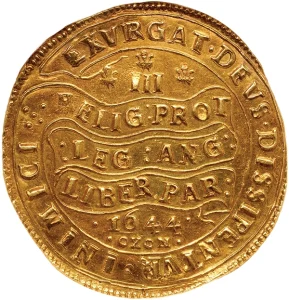
IMAGES COURTESY OF IRA & LARRY
GOLDBERG COINS & COLLECTIBLES
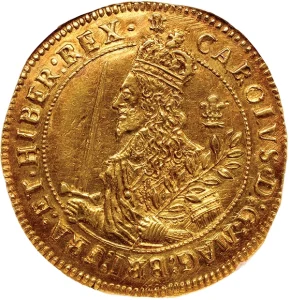
IMAGES COURTESY OF IRA & LARRY GOLDBERG COINS & COLLECTIBLES
An Oxford Mint 1643 Triple Unite was in both the Millennia and Peh Collections. It is an attractive and imposing coin, with much detail. The $54,000 result was a bit of a bargain: At least six higher-quality 1643 Triple Unites have sold during the past 20 years for more than $200,000 each—with one selling for more than $400,000.
Triple Unites of 1644 are much rarer than those of 1643. Fewer than 35 are known. The Millennia-Peh 1644 was NGC-graded as MS-61 before it was auctioned for $178,250 by the Goldbergs on May 26, 2008. At the Jan. 30 auction, the same coin realized $336,000. As market values have risen, the $178,250 price was higher in May 2008 than the $336,000 price was this January.
5 Guineas Frenzy
Starting in 2020, a frenzy for 5 Guineas gold coins came about. Arguably, these became the hottest of all rare gold coins in the world. Five Guineas gold coins of Great Britain were minted from 1668 to 1753. Each one weighs roughly four-thirds of a Troy ounce (1 + 1/3). The coins, which are about 1.45 inches wide, were considered gigantic gold coins in their time and were often emotionally associated with the growth of the British Empire. There were several in the first part of the Peh Collection.
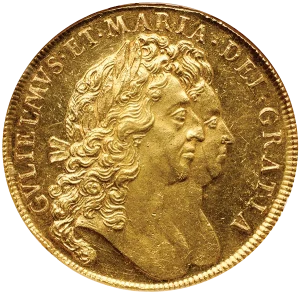
IMAGES COURTESY OF IRA & LARRY GOLDBERG COINS & COLLECTIBLES
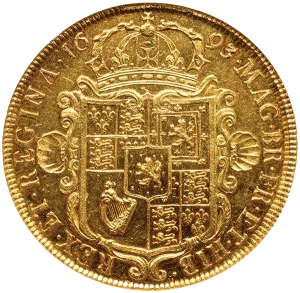
IMAGES COURTESY OF IRA & LARRY GOLDBERG COINS & COLLECTIBLES
King James II was succeeded by his daughter, Mary II, in 1689. She ruled with her husband, William, a prince from the Netherlands. The William & Mary 1693 5 Guineas coin in the Peh Collection was NGC-graded MS-62. At the Jan. 30 auction, it realized $138,000, a very strong price. In May 2007, while coin markets were really flaming, the Goldbergs auctioned this same coin, with the same NGC grade, for $27,600—exactly one-fifth as much as it realized this year.
King William Commands Attention
When Mary II died in 1694, her husband became King William III. At the January 30 auction, a PCGS-graded MS-61 William III 1701 5 Guineas coin realized $87,000. Among 5 Guineas, 1701 is not an especially rare date. The NGC census is 82 with plain scepters, as this coin has, and the PCGS population is 26.
This same coin was in the already cited Goldbergs auction of May 2007, where it sold for $19,550—less than one-fourth of the $87,000 price realized this year, which was a moderate to strong price. A different PCGS-graded MS-61 1701 5 Guineas with plain scepters realized $120,000 in August 2021.
Queen Anne Coin Turns Heads
The most famous coin in the Peh Collection was the Queen Anne 1703 5 Guineas issue. This is extremely rare, popular and very much historically meaningful.
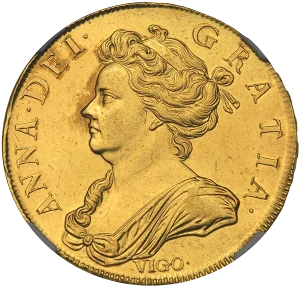
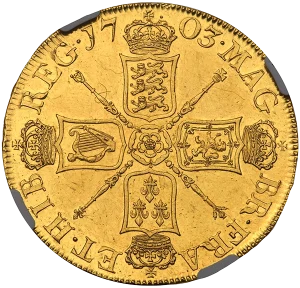
Queen Anne ruled for about 12 years (1702-1714). In sum, Queen Anne 5 Guineas are not that rare. The 1703, 1705 and early 1706, 5 Guineas coins are pre-union issues. Later, 1706 coins, 1709, 1711, 1713, 1714/3 overdate and 1714 normal-date 5 Guineas coins are post-union, struck after the union between England and Scotland was formalized. Shields on the reverse (tail) designs of each British coin differ on pre-union and post-union coins. The 1703 5 Guineas is extremely rare. Importantly, it stands out as the name “Vigo” appears below the portrait of Queen Anne.
In October 1702, an alliance of the British and the Dutch defeated an alliance of Spain and France in a landmark battle in Vigo Bay. The city of Vigo is in the northwest region of Spain. This victory relates to the rise of the British Navy. The 1703 Vigo 5 Guineas is, thus, both a regular issue coin and an important commemorative.
The Queen Anne Vigo 5 Guineas in the Peh Collection was earlier in the Millennia Collection. It was NGC-graded MS-61 with a proof-like designation. In 2008, it realized $414,000; this year it realized $900,000. The $414,000 realization in 2008 was considered a huge price at the time. Since then, the value of British rarities have increased a great deal. The $900,000 price realized was moderate to strong in January of this year.
Greg Reynolds, email: Insightful10@gmail.com.


